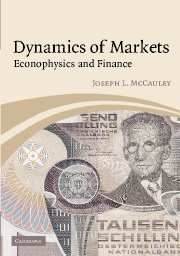Book contents
- Frontmatter
- Contents
- Preface
- 1 The moving target
- 2 Neo-classical economic theory
- 3 Probability and stochastic processes
- 4 Scaling the ivory tower of finance
- 5 Standard betting procedures in portfolio selection theory
- 6 Dynamics of financial markets, volatility, and option pricing
- 7 Thermodynamic analogies vs instability of markets
- 8 Scaling, correlations, and cascades in finance and turbulence
- 9 What is complexity?
- References
- Index
6 - Dynamics of financial markets, volatility, and option pricing
Published online by Cambridge University Press: 31 October 2009
- Frontmatter
- Contents
- Preface
- 1 The moving target
- 2 Neo-classical economic theory
- 3 Probability and stochastic processes
- 4 Scaling the ivory tower of finance
- 5 Standard betting procedures in portfolio selection theory
- 6 Dynamics of financial markets, volatility, and option pricing
- 7 Thermodynamic analogies vs instability of markets
- 8 Scaling, correlations, and cascades in finance and turbulence
- 9 What is complexity?
- References
- Index
Summary
An empirical model of option pricing
Introduction
We begin with the empirical distribution of intraday asset returns and show how to use that distribution to price options empirically in agreement with traders' prices in closed algebraic form. In Section 6.2 we formulate the theory of volatility of fat-tailed distributions and then show how to use stochastic dynamics with the empirical distribution to deduce a returns and time-diffusion coefficient. That is, we solve the inverse problem: given the empirical returns distribution, we construct the dynamics by inferring the local volatility function that generates the distribution.
We begin by asking which variable should be used to describe the variation of the underlying asset price p. Suppose p changes from p(t) to p(t + Δt) = p + Δp in the time interval from t to t + Δt. Price p can of course be measured in different units (e.g., ticks, Euros, Yen or Dollars), but we want our equation to be independent of the units of measure, a point that has been ignored in many other recent data analyses. For example, the variable Δp is additive but is units dependent. The obvious way to achieve independence of units is to study Δp/p, but this variable is not additive. This is a serious setback for a theoretical analysis. A variable that is both additive and units independent is x = ln(p(t)/p(t0)), in agreement with Osborne (1964), who reasoned from Fechner's Law. In this notation Δx = ln(p(t + Δt)/p(t)). One cannot discover the correct exponents μ for very large deviations (so-called “extreme values”) of the empirical distribution without studying the distribution of logarithmic returns x.
- Type
- Chapter
- Information
- Dynamics of MarketsEconophysics and Finance, pp. 121 - 146Publisher: Cambridge University PressPrint publication year: 2004



